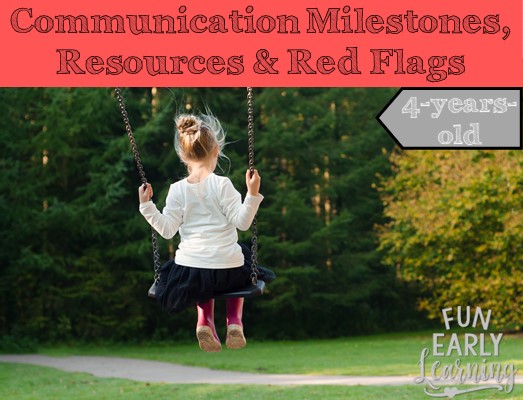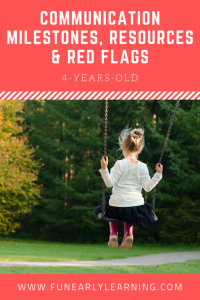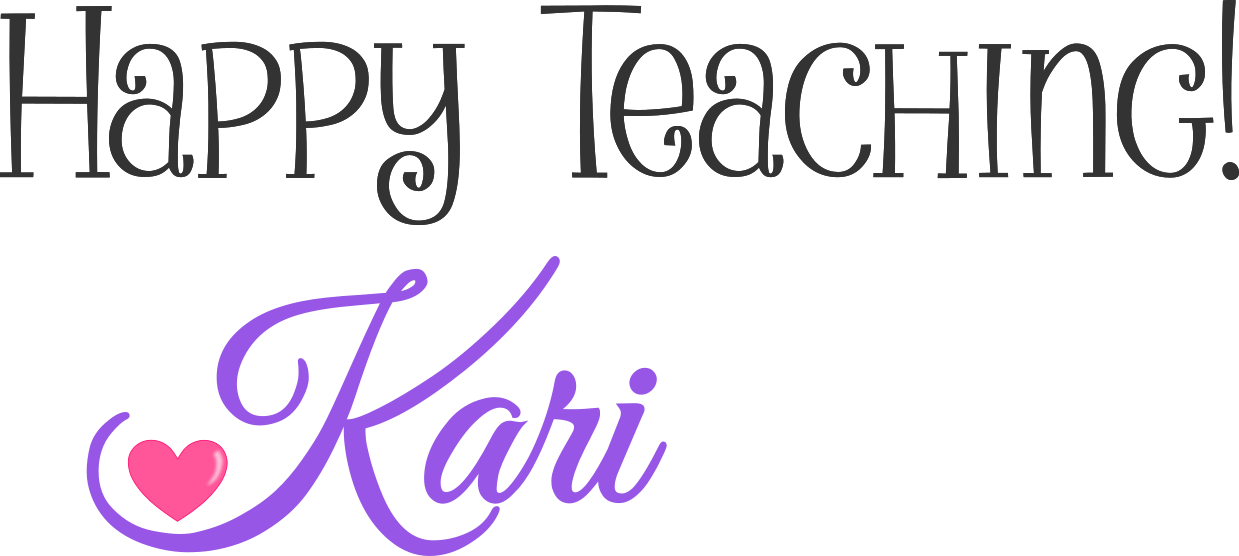
Below is a list of communication milestones, resources and red flags to look for as you determine the best course of action for your 4-year-old child. Most children will acquire new skills following a predictable progression of speech and language development. It’s important to remember that if your child has not mastered a certain skill by the suggested age, or is slightly delayed in a few of the milestone areas, it doesn’t necessarily indicate a speech or language disorder.

Please contact your family doctor for an evaluation, or a speech-language pathologist for a screening, if you are concerned about your child’s communication skills. You can also check with local community associations, universities, health departments and preschools to see if they offer free hearing, speech and language development screenings in your community.
Communication Milestones, Resources and Red Flags – 4-Years-Old
Articulation (Sounds)
- By 4 years of age, a child should be able to consistently make the following sounds correctly: /p/, /b/, /m/, /h/, /n/, /w/, /d/, /k/, /g/, /d/, /f/, “y”
- By 4 years of age, a child should be understood about 90% of the time by unfamiliar listeners
- May still have errors on later-developing sounds such as /s/, “sh”, “ch”, “j,” “th”, /r/, /l/
These errors are OKAY!
Expressive Language
A 4-year-old child should have a vocabulary of roughly 1600 words and correctly use the following grammatical markers:
- Produces sentences with an average length of 3 to 5 words (or more)
- Uses pronouns
- Subjective (I, you, he, she, we, they)
- Objective (me, him, her, us, them)
- Possessive (my, mine, his, her, hers, their, theirs, our, ours, your, yours)
- Uses “-ing” at the end of verbs (such as “playing”, “running”, and “jumping”)
- Uses plural “-s” (e.g., muffins, toys, shoes)
- He/she uses possessive “-s” (e.g., Mommy’s dress)
- Uses past tense verbs “-ed” (e.g., jumped and kicked)
- Uses articles (a baby, the house)
- He/she uses the conjunction “and”
- Asks a variety of questions, including “yes/no”, “what,” “where”, “when”, “how”, “whose”, and “why?”
- Asks “is” questions, (e.g., “What is that?” or “Is he sleeping?”
Receptive Language
- Identifies same/different (points to the object that is different than the others)
- Identifies colors
- Matches one-to-one (can match two items that are the same)
- Follows quantity directions such as “Point to the empty bowl” or “Point to the bowl that has a lot.”
- Follows equality directions such as “Point to the toys that are the same” or “Pick up both toys”
- Uses position concepts such as “next to”, “beside”, “behind”, “in front” and “around”
- Answers a variety of questions
- Yes/No
- Wh questions: Who, what, where, when, why
- How, when and how many
Social Language/Pragmatic Skills
- Follows simple 2-step directions without cues (“get your coat and put it on”)
- Takes turns and plays cooperatively
- Relates personal experiences through verbalization
- Frequently practices conversation skills by talking to self
- Begins dramatic play, acting out whole scenes
- Shows frustration if not understood
- Expresses ideas and feelings
Red Flags
Speak with your family doctor if your child displays any of the following signs of a possible language delay or disorder for this age range.
- Produces speech that is difficult to understand by family or familiar people
- Sentences are not growing in length or complexity
- Difficulty answering questions: what, where, what-doing?
- Not asking who, what, or where questions
- Difficulty putting sentences together
- Difficulty expressing ideas and feelings
- Little interest in talking to adults or children
- Doesn’t follow verbal directions
What Can I Do to Help My Child Develop Language and literacy Skills?
That’s a very common question that we get. Click here to find out what you can do to help your child’s language and literacy development.

Adapted from: LinguiSystems Guide to Communication Milestones
Retrieved from https://www.linguisystems.com/pdf/Milestonesguide.pdf
The information contained on this website should not be used as a substitute for the medical care and advice of your pediatrician or Speech Language Pathologist.

